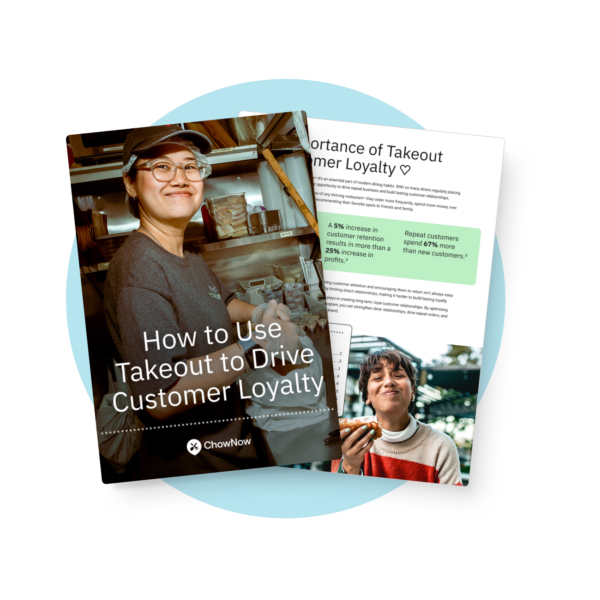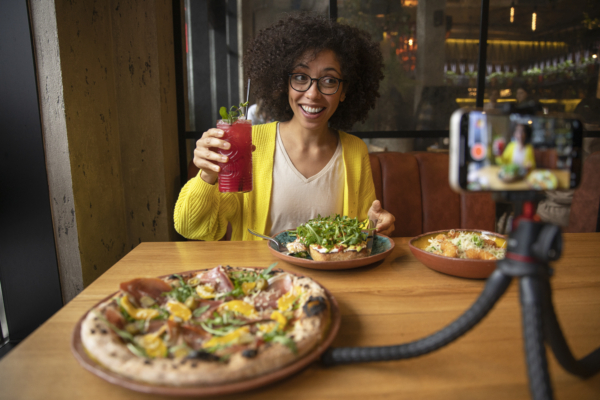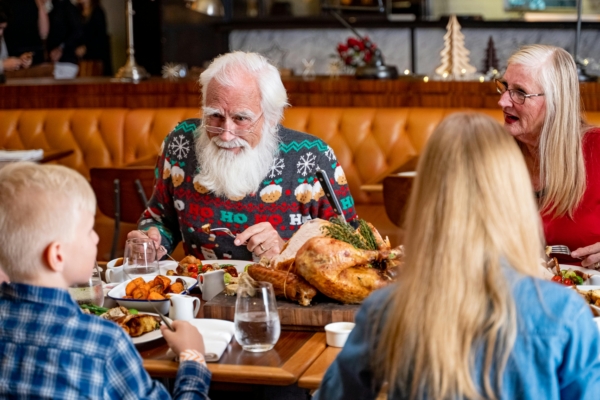How to Measure and Improve Restaurant Marketing ROI (Free Calculator Inside)

You’d never run your kitchen without knowing your food costs, so why would anyone run their marketing campaigns without knowing the return on investment?
Too many restaurant operators pour time and money into marketing efforts, then cross their fingers and hope for the best.
When it does work, they have no idea what’s actually driving the results.
The confusion is made even worse when spread across multiple marketing channels.
Without dissecting what’s increasing business, they keep pumping money into the same two to three channels—when the reality could be that only one of those channels is doing all the heavy lifting, potentially wasting thousands on marketing efforts that bring in zero return on investment.
That’s why understanding (and improving) your restaurant marketing ROI is one of the smartest moves you can make as an operator.
In this article, you’ll learn:
- How to confidently calculate ROI for your restaurant’s marketing
- How to spot waste and double down on the marketing tactics that work
- Practical ways to improve the ROI of your restaurant marketing strategy
What Is Restaurant Marketing ROI?
Restaurant marketing ROI (return on investment) tells you whether your restaurant marketing strategies are actually making you money.
It compares how much you spend on marketing channels, like:
- Ads
- Tools
- Promos
- Social Media
- Signage and In-Store Marketing
- Influencer Partnerships
—to how much extra revenue those efforts generate.
The basic idea is: for every dollar you put into marketing, how many dollars are you getting back?
Why Marketing ROI Matters for Restaurant Operators
Restaurant operators don’t have “play money”—they can’t afford to lose capital on bad decisions and marketing guessing games, which is why insights and data are such incredibly valuable assets to any business.
Tracking your restaurant marketing ROI is the clearest way to make the most of your marketing budget and learn which strategies are working and which ones either need to go or be reworked.
Here’s why it matters.
Prioritize the most profitable marketing channels
Instead of spreading your marketing budget across every platform, ROI data shows which marketing campaigns connect best with new customers, drive repeat visits, and increase average order volume, so you can double down on strategies that move the needle.
You’ll make smarter marketing budget decisions
When you fully grasp the ROI of your marketing spend, it’s easier to cut strategies you know, for a fact, aren’t working and reinvest in campaigns that deliver, helping you control marketing costs and reduce waste.
Understand what’s driving results
Clear ROI reporting ties marketing efforts directly to restaurant performance. It helps you see how different tactics contribute to net profit, customer engagement, and long-term growth.
Tracking ROI gives you the control every successful restaurant marketing strategy needs. You’re not relying on gut feelings or “what everyone else is doing,” you’re making data-backed choices based on real results.
How to Calculate Restaurant Marketing ROI
Calculating restaurant marketing ROI isn’t complicated. The formula looks like this:

This gives you a percentage that tells you how much return you’re getting for every dollar spent.
If you spend $1,000 and make $4,000 in net profit, your ROI is 400%. That means for every $1 in marketing expenses, you’re getting $4 back.
Let’s say you spend $1,000 on a local ad campaign. That campaign brings in $3,000 in revenue, and after subtracting your cost of goods sold, labor costs, and other marketing expenses, you’re left with $1,500 in net profit.
Here’s how it breaks down:
ROI = ($1,500 / $1,000) × 100 = 150%
That means for every dollar you spent, you made $1.50 in profit.
Restaurant Marketing ROI Calculator
Want to see how well your marketing campaigns are performing? Use our free Restaurant Marketing ROI Calculator. Simply enter your campaign revenue, costs, and marketing expenses to calculate your ROI.
What counts as marketing cost?
Your marketing costs should include everything tied to running the campaign, not just the ad spend.
That includes:
- Design fees or creative work
- Software tools (like email platforms or POS systems with marketing features)
- Paid placements (like Google Ads or local sponsorships)
- Staff time spent managing marketing efforts
Leaving these out leads to misleading numbers and often inflated ROI.
What counts as a return?
This is where things get tricky—and where many restaurants overestimate their ROI. You can’t count just your total revenue.
To get the actual net profit, you need to subtract costs like inventory, labor, and marketing spend. And most importantly, only include the extra revenue directly tied to the campaign you’re measuring.
That might be:
- A spike in orders following an email blast
- First-time visits from a loyalty signup promo
- Extra orders from a social media discount
When in doubt, be conservative. It’s better to measure a slightly understated but real return on investment than chase a vanity number that doesn’t reflect actual growth.
What Is a Good Marketing ROI for Restaurants?
There’s no universal “good” restaurant marketing ROI number because many factors contribute to what makes a successful return on investment.
If you’re a new restaurant trying to build awareness, a lower short-term ROI might be acceptable. Early marketing efforts may be about building a loyal customer base or reaching your target market, not just immediate profit.
On the other hand, an established restaurant might aim for higher ROI and stricter cost control, since your brand recognition is already in place.
That said, for most restaurants, a marketing ROI of 300% to 500% (or $3-$5 return for every $1 spent) is considered strong, especially for digital marketing channels where performance is easier to track.
In either case, it’s not just about the number—it’s about whether your restaurant marketing strategy is helping you maximize profitability over time.

Common Mistakes to Avoid When Measuring ROI
These are the most common pitfalls restaurant operators run into when tracking marketing ROI:
Not tracking results by channel or campaign
If you’re lumping all your marketing efforts together, you’ll never know what’s really driving results.
Email marketing might be killing it while social media isn’t bringing the results you need—but if you don’t track each channel separately, you’ll miss that insight. Use UTM links, campaign tags, or basic reporting tools to isolate performance.
Counting all revenue instead of incremental lift
Let’s say your restaurant normally does $10K a week. You launch a marketing campaign, and revenue hits $11K. Only $1K of that is from the campaign—that’s your incremental return.
Don’t make the mistake of crediting the full $11K to your marketing, or your actual ROI will look way better than it really is.
Ignoring long-term brand impact or repeat customer value
Some tactics, like loyalty programs or content marketing, may not pay off immediately but drive more repeat business and customer loyalty over time.
Ignoring those effects gives you an incomplete picture.
Leaving out important costs
To calculate actual ROI, include all marketing expenses, not just ad spend.
That means labor costs, design fees, software, and anything else tied to the campaign. Underestimating your total cost leads to inflated results.
Ways to Improve Your Restaurant Marketing ROI
Once you understand how your marketing efforts are performing, the next step is optimizing your returns. That doesn’t necessarily mean spending more money; it means spending better in the right places.
Here are proven ways to boost your restaurant marketing ROI:
Focus on direct commission-free ordering channels
Third-party platforms take a cut. Driving traffic to your own restaurant website or branded mobile app helps you keep more of the gross profit and build stronger connections with loyal customers.
Automate your retention marketing
Tools like email, push notifications, and loyalty programs help drive repeat visits with minimal effort.
Email marketing, in particular, offers one of the highest ROIs ($42 for every $1 spent) in the entire restaurant industry, making it a must-have in your marketing strategy.
Invest in high-impact, low-cost tactics
Not every win requires a huge marketing budget. Organic social media, online reviews, and local SEO are all low-cost channels that, over time, can deliver strong restaurant marketing ROI.
They build trust, drive traffic, and improve visibility, all without paying for every click.
Test and optimize campaigns
The first version of a campaign is rarely the best. A/B testing subject lines, images, and offers helps you steadily improve performance.
Even small changes can lead to better engagement, higher conversion rates, and more revenue for the same marketing spend.
Track and review results regularly
Set aside time each month to review your marketing ROI. Look at both short-term returns and long-term gains, like customer loyalty or shifts in restaurant performance.
The more consistent your review process, the easier it is to make informed decisions.
Examples of Restaurant Marketing Channels and Their ROI Impact
Not all marketing tactics deliver the same return. Some are designed for long-term growth, while others drive quick wins. Understanding how different channels contribute to your restaurant marketing ROI helps you make better marketing decisions.
Here’s a breakdown of popular channels and what kind of impact they tend to have.
Email marketing
Low cost, easy to automate, and highly effective at driving repeat business. Email consistently ranks as one of the highest-ROI marketing channels, especially when targeting loyal customers with promotions, updates, and personalized offers.
Local SEO
When someone searches “best tacos near me” and your restaurant shows up, they’re ready to eat and want to place an order.
Investing in your Google Business Profile, getting reviews, and optimizing for local search can bring in customers without ongoing ad spend, making it a long-term win for restaurant ROI.
Loyalty programs
Loyalty programs boost customer retention and lifetime value by rewarding guests for repeat visits. They can also generate useful customer data to guide future campaigns.
Paid search
Platforms like Google Ads let you target people actively looking for what you offer.
Ads can drive fast, trackable results when done right. Just make sure you’re monitoring performance closely so you’re not overspending your marketing budget.
Social media
While organic social media content supports brand-building, it is harder to tie directly to revenue.
Restaurant Marketing ROI Frequently Asked Questions
What is the average ROI for restaurant marketing?
There’s no fixed number because every restaurant has different marketing goals and variables, like:
- Location
- Demographics
- Concept and pricing
- Marketing channels used
- Campaign objectives (awareness vs. direct sales)
That said, many restaurants aim for a marketing ROI of 300% or higher, meaning they make $3 in profit for every $1 spent. But what matters most is that your ROI is positive, consistent, and improving over time.
The key is tracking your results so you know what’s actually working and where to double down.
Should I include labor costs in my marketing ROI?
Yes. To calculate actual ROI, you need to include labor costs tied to your marketing campaigns, whether that’s a staff member managing social media or someone designing a flyer. Leaving those out gives you an inflated view of performance and can lead to poor marketing decisions.
How long should I track a campaign before calculating ROI?
It depends on the channel. For email or paid ads, you can often measure results within a week or two. For slower-moving tactics like SEO or loyalty programs, give it a few months to see real impact. Either way, make sure you’re isolating the results of each campaign to calculate ROI accurately.
Is ROI the only metric I should care about?
No. While marketing ROI is critical, it’s not the only thing that matters. Metrics like customer lifetime value, customer satisfaction, customer acquisition cost, and engagement can give you deeper insight into how well your marketing strategy supports sustainable growth.
ROI tells you what’s working today, but these other metrics show whether your efforts will pay off long term.
How can I track ROI if my restaurant uses multiple marketing platforms?
Start by tagging and tracking each campaign separately, use promo codes, trackable links, or analytics tools that integrate across platforms.
Look for ways to connect your POS system, email platform, and advertising tools so you can measure performance in one place.
The more organized your customer data and campaign tracking are, the easier it is to isolate results and make informed decisions.
ROI Should Guide Your Restaurant Marketing Decisions
The most effective marketing strategies are based on real numbers, not guesswork. When you use restaurant marketing ROI to guide your decisions, you’re significantly increasing the odds that your marketing efforts will help your restaurant grow faster and make better use of your marketing budget.
Contact ChowNow to learn how Automated Email Marketing and a Rewards Program can increase your ROI and lead to more repeat orders.






